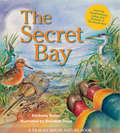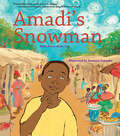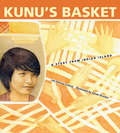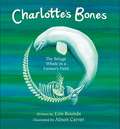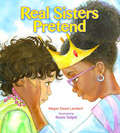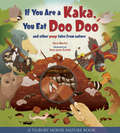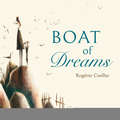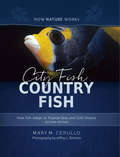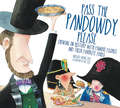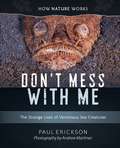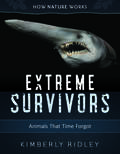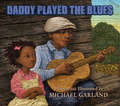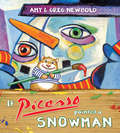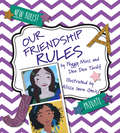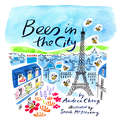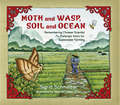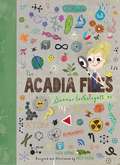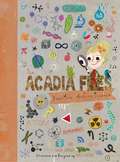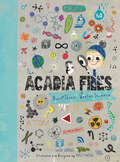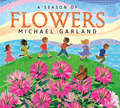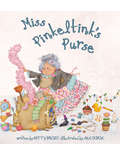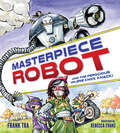- Table View
- List View
The Secret Bay (Tilbury House Nature Book)
by Rebekah Raye Kimberly Ridley<P><P>AWARDS: *Moonbeam Silver*, *John Burroughs Association Riverby 2016 Award* <P><P> Estuaries form where river meets sea and fresh water mixes with salt. Teeming with life, these places of salt marshes, mudflats, and tidal backwaters serve as nursery areas for oceangoing fish, migratory stopovers for shorebirds, and homes for an amazing diversity of snails, bivalves, fish, mammals, horseshoe crabs, fiddler and blue crabs, terrapin turtles, plankton, and many others, all of whom we meet in the pages of this delightful book. <P><P> Narrated in the poetic voice of the estuary itself, and accompanied by natural-history sidebars about estuary plants, animals, and cycles, THE SECRET BAY is another topnotch nature book from the author and illustrator of the award-winning, bestselling The Secret Pool. <P><P> A stand-alone book and a stunning companion volume to Ridley and Raye’s award-winning Secret Pool. Ridley deftly augments the estuary’s lyrical narrative voice with sidebars about the plants, animals, and natural processes of an estuary. Raye’s gorgeous watercolors reveal new features and hidden treats with each reading. Back matter includes The Estuary Food Web, Great Escapes (how estuary animals avoid predators), and an author’s note about the challenges facing estuaries. A perfect book for the budding naturalist and for his or her parents and teachers. <P><P> Fountas & Pinnell Level S Lexile 1180
Amadi's Snowman: A Story Of Reading
by Katia Novet Saint-Lot Dimitria TokumboWhy does Amadi's mother insist he learn to read words when he is going to be a great businessman? Why should an Igbo man of Nigeria waste precious time on books, anyway? When Amadi disobeys his mother and runs off to the market instead of sticking around for a reading lesson, he encounters a much-admired older boy secretly reading at a book stall. Crowding himself in among the stacks of books, Amadi becomes intrigued by a storybook with pictures of a strange white creature with a carrot for a nose. Over the course of a typical mischievous day, unable to shake his questions about the snowman, Amadi discovers the vast world reading could open up--especially for an Igbo man of Nigeria.
Kunu's Basket: A Story From Indian Island
by Lee Decora Francis Susan DruckerYoung Kunu wants to make a pack basket on his own. He's watched his dad and his grandfather make baskets on Indian Island, but now that he's trying to make one for himself, it s not as easy as he thought it would be. Kunu isn't a quitter, but he gets so frustrated that he has to go outside to cool off. When his grandfather asks Kunu to help him with some basket-making tasks, Kunu comes to understand that it is the tradition in his family for one generation to help the next. He also learns that it might take several tries before he gets it right. Can he be patient enough to try again and again? His grandfather shows him the way, and at last Kunu's first basket is something to celebrate.
Charlotte's Bones: The Beluga Whale In A Farmer's Field (Tilbury House Nature Book #0)
by Erin Rounds Alison CarverMany thousands of years ago, when a sheet of ice up to a mile thick began to let go of the land, the Atlantic Ocean flooded great valleys that had been scooped out by glaciers, and the salty waves of an inland sea lapped the green hills of Vermont. Into this arm of the sea swam Charlotte. Her milky, smooth, muscled body sliced slowly through the water like scissors through silk. Like a chirping canary, her voice echoed across dark waters showing the way to her pod as belugas have done for millions of years. In 1849, a crew building a railroad through Charlotte, Vermont, dug up strange and beautiful bones in a farmer’s field. A local naturalist asked Louis Agassiz to help identify them, and the famous scientist concluded that the bones belonged to a beluga whale. But how could a whale’s skeleton have been buried so far from the ocean? The answer—that Lake Champlain had once been an arm of the sea—encouraged radical new thinking about geological time scales and animal evolution. Charlotte’s Bones is a haunting, science-based reconstruction of how Charlotte died 11,000 years ago in a tidal marsh, how the marsh became a field, how Charlotte found a second life as the Vermont state fossil, and what messages her bones whisper to us now about the fragility of life and our changing Earth. Lexile 940; F&P Level P
Real Sisters Pretend
by Nicolle Tadgell Megan Dowd LambertThis warm, engaging story, which unfolds entirely through the conversation of two adopted sisters, was inspired by the author's own daughters, whom she overheard talking about how adoption made them real sisters even though they have different birth parents and do not look alike. I liked how they took care of one another in their pretend-play scenario about climbing a mountain, Lambert says, and I loved how they also took care of one another s feelings as they talked about adoption. Real Sisters Pretend captures these interactions perfectly and movingly. Told with simple words and playful illustrations, this book touches on the topics of adoption, two moms, and multiracial family life. Illustrated by award-winning artist Nicole Tadgell. Modern families can look very different from the nuclear families of yesteryear, but as Lambert says in the book's introduction, No matter how a family comes to be, the most important thing is for everyone to feel loved, safe, and cared for. Real Sisters Pretend is a great vehicle for sharing that love and reassurance.
If You Are A Kaka, You Eat Doo Doo: And Other Poop Tales From Nature (Tilbury House Nature Book #0)
by Sara Lynn Cramb Sara MartelWombat poos are box-shaped to stay where they're deposited and serve as messages to other animals. Baby golden tortoise beetles pile poop on their backs to create a shield as protection from predators. Silver-spotted skipper caterpillars can shoot their poops 40 times their own body length to conceal their true locations. Baby hoopoes squirt their poops into the eyes of attackers, and who wants feces in their faces? Baby Ozark blind cave salamanders use gray bat guano for food. The bottom (!!) line: Ever-inventive Nature finds a thousand uses for poop. Nothing goes to waste (!!). This book is a guaranteed crowd-pleaser with a lot of information to share.
Boat of Dreams
by Rogério CoelhoSelected for the 2018 Bank Street College of Education Best Children’s Books of the Year 2017 NYPL Best Books for Kids List *2017 IPPY Independent Publishers Gold Medalist* *Starred Review School Library Journal* *Starred Review- Booklist**Brazil's 2015 Jabuti Award for best children's illustration* How does a fastidious old man with bowler, umbrella, suspenders, and a Salvador Dali mustache come to live on a deserted island? How does a boy come to live alone in an apparently deserted city? Are they separated by distance or by time? Does the man dream the boy? Does the boy dream the man? Is a blank paper in a floating bottle an invitation to imagine our futures? Is the man’s flying boat an encouragement to the boy to dream? Are the man and the boy the same person—the boy dwelling in the man’s memory? Is a message in a bottle the earthbound dreams of the elderly? Is a flying boat the unconstrained dreams of the young? This wordless, many-layered 80-page picture book invites all these interpretations and more. The intricately detailed illustrations reveal new wonders with each viewing. Neither children nor adults will ever tire of this wonderful testament to imagination, memory, and dreams.
City Fish Country Fish: How Fish Adapt To Tropical Seas And Cold Oceans (How Nature Works #0)
by Mary M. Cerullo Jeffrey L. Rotman* School Library Journal Starred Review * * Honor Book SSLI (Society of School Librarians International) * *Skipping Stones Honor Book* Fish that live in tropical seas are like city dwellers, packed into reefs and surrounded by life in great variety and urgent motion,Fish that live in tropical seas are like city dwellers, packed into reefs andsurrounded by life in great variety and urgent motion, day and night. Through color, shape,size, and other adaptations, city fish and country fish have evolved to survive in their particular habitats.In City Fish, Country Fish, Mary Cerullo uses this powerful analogy and Jeffrey Rotman’s vibrant underwater photos to captivate young readers with the wild variety of ocean life. The second edition of this popular book includes new information about the effects of climate change on fish and their habitats and about great white sharks, who are among the few species who roam back and forth between cold and tropical waters. Fountas & Pinnell Level T
Far Side of the Moon: The Story Of Apollo 11's Third Man
by Alex Irvine Ben Bishop*Junior Library Guild Selection 2017* A unanimous selection to the 2018 Maverick Graphic Novel List! This graphic retelling of the Apollo 11 moon-landing mission follows astronaut Michael Collins, commander of the lunar orbiter, to the far side of the moon. When the Earth disappears behind the moon, Collins loses contact with his fellow astronauts on the moon’s surface, with mission control at NASA, and with the entire human race, becoming more alone than any human being has ever been before. In total isolation for 21 hours, Collins awaits word that Neil Armstrong and Buzz Aldrin have managed to launch their moon lander successfully to return to the orbiter—a feat never accomplished before and rendered more problematic by the fuel burn of their difficult landing. In this singularly lonely and dramatic setting, Collins reviews the politics, science, and engineering that propelled the Apollo 11 mission across 239,000 miles of space to the moon. Fountas & Pinnell Level U <P><P> <i>Advisory: Bookshare has learned that this book offers only partial accessibility. We have kept it in the collection because it is useful for some of our members. Benetech is actively working on projects to improve accessibility issues such as these.</i>
Pass The Pandowdy, Please: Chewing On History With Famous Folks And Their Fabulous Foods
by Abigail Zelz Eric Zelz*CBC/NCSS Notable Social Studies Trade Book* What do Napoleon, Cleopatra, George Washington, Gandhi, Queen Victoria, Columbus, Neil Armstrong, Montezuma, Paul Revere, Babe Ruth, Abraham Lincoln, Sacagawea, and Katsushika Hokusai have in common? They are all among the historical figures portrayed in this delightful book by writer Abby Ewing Zelz and cartoonist Eric Zelz. Just like us, the great movers and shakers of history had to eat, and their favorite foods turn out to be a highly entertaining thread to follow through the history of our small planet. History and biography have never been this tasty! Includes do it yourself historic Pandowdy recipe Includes backmatter with brief bios of featured historic figures Fountas & Pinnell Level W
Finding the Speed of Light: The 1676 Discovery That Dazzled The World
by Mark WestonKirkus Star Mark Weston’s high-interest story and Rebecca Evans’s colorful graphics make scientific discovery the coolest thing this side of Jupiter. More than two centuries before Einstein, using a crude telescope and a mechanical timepiece, Danish astronomer Ole Romer measured the speed of light with astounding accuracy. How was he able to do this when most scientists didn’t even believe that light traveled? Like many paradigm-shattering discoveries, Romer’s was accidental. Night after night he was timing the disappearance and reappearance of Jupiter’s moon Io behind the huge, distant planet. Eventually he realized that the discrepancies in his measurements could have only one explanation: Light had a speed, and it took longer to reach Earth when Earth was farther from Jupiter. All he needed then to calculate light’s speed was some fancy geometry.
Don't Mess With Me: The Strange Lives Of Venomous Sea Creatures (How Nature Works #0)
by Paul Erickson Andrew MartinezThe role of venoms in nature … and in human medicine Why are toxins so advantageous to their possessors as to evolve over and over again? What is it about watery environments that favors so many venomous creatures? Marine biologist Paul Erickson explores these and other questions with astounding images from Andrew Martinez and other top underwater photographers. GREAT for teaching STEM Marine Biology Scorpions and brown recluse spiders are fine as far as they go, but if you want daily contact with venomous creatures, the ocean is the place to be. Blue-ringed octopi, stony corals, sea jellies, stonefish, lionfish, poison-fanged blennies, stingrays, cone snails, blind remipedes, fire urchins—you can choose your poison in the ocean. Venoms are often but not always defensive weapons. The banded sea krait, an aquatic snake, wriggles into undersea caves to prey on vicious moray eels, killing them with one of the world’s most deadly neurotoxins, which it injects through fangs that resemble hypodermic needles.
Extreme Survivors: Animals That Time Forgot (How Nature Works #0)
by Kimberly Ridley<p>Selected for the 2018 Bank Street College of Education Best STEM Children’s Books of the Year <p>What do the goblin shark, horseshoe crab, the “indestructible” water bear, and a handful of other bizarre animals have in common? <p>They are all “extreme survivors,” animals that still look much like their prehistoric ancestors from millions of years ago. <p>Meet ten amazing animals that appear to have changed little in more than 100 million years. They are the rare exceptions to the rule. <p>More than 99 percent of all life forms have gone extinct during the 3.6-billion-year history of life on Earth. Other organisms have changed dramatically, but not our extreme survivors. Evolution may have altered their physiology and behavior, but their body plans have stood the test of time. <p>How have these living links with Earth’s prehistoric past survived? The search for answers is leading scientists to new discoveries about the past—and future—of life on Earth. The survival secrets of some of these ancient creatures could lead to new medicines and treatments for disease. <p>Written in a lively, entertaining voice, Extreme Survivors provides detailed life histories and strange “survival secrets” of ten ancient animals and explains evolution and natural selection. Extensive back matter includes glossary, additional facts and geographic range for each organism and a geologic timeline of Earth. <p><B>F&P Level V </B> <P><P><i>Advisory: Bookshare has learned that this book offers only partial accessibility. We have kept it in the collection because it is useful for some of our members. To explore further access options with us, please contact us through the Book Quality link. Benetech is actively working on projects to improve accessibility issues such as these.</i>
Daddy Played the Blues
by Michael Garland*Notable Social Studies Trade Books Selection for Young People 2018* “I was six years old the day we left the farm in Mississippi,” remembers Cassie in this richly textured picture book. “Between the boll weevils, the floods, and the landlord, there was no way a family could scratch out a living there anymore.” Packing themselves into an old jalopy—with Daddy, Uncle Vern, and Mama in the front seat and Cassie and her two brothers in the back—they joined the Great Migration from the impoverished Deep South to Chicago, where there was work to be had in the stockyards. Across the kids’ laps lay Daddy’s prized possession, a six-string guitar. Daddy worked hard to put food on the table, but what he really loved was playing the blues. This evocative tale of the African-American odyssey in search of a better life is also a homage to the uniquely American music that developed from African music and American spirituals, work songs, and folk ballads. In the book’s backmatter, Garland relates how he first heard and fell in love with blues music, beginning a lifelong fandom. Portraits and thumbnail biographies of great blues musicians and landmark songs complete this tribute to the great American music and the yearnings that produced it. Fountas & Pinnell Level S
If Picasso Painted a Snowman
by Amy Newbold Greg NewboldMaryland Blue Crab Honor Book 2018 A big, brightly colored, playful introduction to various important painters and art movements. If someone asked you to paint a snowman, you would probably start with three white circles stacked one upon another. Then you would add black dots for eyes, an orange triangle for a nose, and a black dotted smile. But if Picasso painted a snowman… From that simple premise flows this delightful, whimsical, educational picture book that shows how the artist’s imagination can summon magic from a prosaic subject. Greg Newbold’s chameleon-like artistry shows us Roy Lichtenstein’s snow hero saving the day, Georgia O’Keefe’s snowman blooming in the desert, Claude Monet’s snowmen among haystacks, Grant Wood’s American Gothic snowman, Jackson Pollock’s snowman in ten thousand splats, Salvador Dali’s snowmen dripping like melty cheese, and snowmen as they might have been rendered by J. M. W. Turner, Gustav Klimt, Paul Klee, Marc Chagall, Georges Seurat, Pablita Velarde, Piet Mondrian, Sonia Delaunay, Jacob Lawrence, and Vincent van Gogh. Our guide for this tour is a lively hamster who—also chameleon-like—sports a Dali mustache on one spread, a Van Gogh ear bandage on the next. “What would your snowman look like?” the book asks, and then offers a page with a picture frame for a child to fill in. Backmatter thumbnail biographies of the artists complete this highly original tour of the creative imagination that will delight adults as well as children. Fountas & Pinnell Level O
Our Friendship Rules
by Peggy Moss Dee Dee Tardif Alissa Imre Geis*Moonbeam GOLD Award* Our Friendship Rules is a story of betrayal and forgiveness and a guidebook on relationships. A vibrant new cover and new backmatter suggesting the rules of an enduring friendship highlight this new edition of a Tilbury House children’s classic. Kids are under a lot of pressure to fit in. Sometimes bowing to this pressure forces them to betray their own ideas of what is right and wrong. Alexandra and Jenny have been best friends for a long time, but when Alexandra is dazzled by a glamorous new girl at school, she’s willing to do almost anything to be the cool girl’s friend, including first shunning Jenny and then revealing Jenny’s biggest, most important secret. Seeing the hurt she has caused and realizing how bad it feels to lose her best friend, Alexandra then seeks a way to regain the relationship that means far more to her than being invited to sit with the popular girls. Ultimately, she and Jenny write down the rules that will cement their friendship forever. OUR FRIENDSHIP RULES is both a lyrical story of forgiveness and a guidebook on relationships. Author Peggy Moss employs her training as a mediator and communication expert to provide a simple, sweet but instructive tale of how to get along. The evocative collage-paintings of Alissa Imre Geis further illustrate the many layers of personality. Her Alexandra will amaze you with her artistic eye, and her Jenny will make you smile with her practical sensibility as you see these best friends reconnect with the help of their friendship rules. Fountas & Pinnell Level O
Bees in the City
by Andrea Cheng Sarah McMenemy2018 Green Earth Book Award Finalist Lionel lives in a Paris apartment building but loves keeping bees with his Aunt Celine at her farm outside the city. But when her bees start dying, how can he help? The solution, he realizes, is in the rooftop gardens and window boxes of his apartment neighbors, representing a varied and continuously blooming array of flowers that the bees will love. Aunt Celine must bring her bees to Paris! But first he and his friends Alice and Samir must convince their skeptical neighbors and landlord, Mr. Dubi, that this is a good idea. Adorned with Parisian skylines, Bees in the City is a love letter to the City of Light and a celebration of the can-do spirit of kids. Sarah McMenemy’s illustrations recall the Parisian magic of Madeleine. The book’s backmatter explores urban beekeeping and rooftop gardening in greater depth. Fountas & Pinnell Level P
Moth and Wasp, Soil and Ocean: Remembering Chinese Scientist Pu Zhelong
by Sigrid Schmalzer Melanie Linden ChanMoth and Wasp, Soil and Ocean tells its story through the memories of a farm boy who, inspired by Pu Zhelong, became a scientist himself. The narrator is a composite of people Pu Zhelong influenced in his work. With further context from Melanie Chan’s historically precise watercolors, this story will immerse young readers in Chinese culture, the natural history of insects, and the use of biological controls in farming. Backmatter provides context and background for this lovely, sophisticated picture book about nature, science, and Communist China. “The first time I saw a scientist in my village was also the first time I saw a wasp hatch out of a moth’s egg,” writes the narrator of this picture book about Chinese scientist Pu Zhelong. “In that moment I could not have said which was the more unexpected—or the more miraculous.” In the early 1960s, while Rachel Carson was writing and defending Silent Spring in the U.S., Pu Zhelong was teaching peasants in Mao Zedong’s Communist China how to forgo pesticides and instead use parasitic wasps to control the moths that were decimating crops and contributing to China’s widespread famine. This story told through the memories of a farm boy (a composite of people inspired by Pu Zhelong) will immerse young readers in Chinese culture, the natural history of insects, and sustainable agriculture. Backmatter provides historical context for this lovely, sophisticated picture book. The author, Sigrid Schmalzer, won the Joseph Levenson Post-1900 Book Prize for 2018 for her book Red Revolution, Green Revolution. This is the most prestigious prize for a book about Chinese history, and the book upon which Moth and Wasp, Soil and Ocean is based. Fountas & Pinnell Level U
The Acadia Files: The Summer Investigations (The Acadia Files #1)
by Katie Coppens Holly HatamThe Acadia Files: Summer Investigations presents five summer stories, each one followed by Acadia’s science notebook pages with her simple explanations and lively, whimsical drawings of natural phenomena. The Acadia Files is a fun introduction to the wonders of science, using real-world scenarios to make scientific inquiry relatable and understandable. Parents and educators can use The Acadia Files to let kids discover for themselves what it’s like to be curious about the world and to satisfy that curiosity with scientific thinking. Acadia Files for autumn, winter, and spring will follow on future lists. The Acadia Files: Summer Investigations offers an engaging new way to apply the scientific method to real-world scenarios. Great for teaching STEAM Acadia Greene wants answers. Who keeps stealing her blueberries just as they ripen on the bushes? Why is her hair curly? Why does the sun wake her up so early in the summer? Why does the tide submerge her sandcastles? How do rocks become sand? Acadia doesn’t set out to do science, but she has these important questions and her scientist parents refuse to simply feed her the answers. “Conduct an experiment,” they tell her. “Use the scientific method.” So Acadia gathers evidence, makes hypotheses, designs experiments, uses the results to test her hypotheses, and draws conclusions. Acadia does science.
The Acadia Files: Book Two, Autumn Science (The\acadia Files Ser. #1)
by Katie Coppens Holly HatamBooks that explore science through adventure The Acadia Files: Book Two, Autumn Science presents five stories of fall, each one followed by Acadia’s science notebook pages with her simple explanations and lively, whimsical drawings of natural phenomena. The Acadia Files is a fun introduction to the wonders of science, using real-world scenarios to make scientific inquiry relatable and understandable. Parents and educators can use The Acadia Files to let kids discover for themselves what it’s like to be curious about the world and to satisfy that curiosity with scientific thinking. Acadia Greene wants answers. What happened to the frogs she used to see at her favorite local pond? Why do leaves change color in the fall, and why don’t evergreen needles do the same? What is the water cycle, and what is transpiration? How do time zones work, and why does the sun set at different times in different places within a single zone? How do germs infect us? Acadia doesn’t mean to do science, but she has questions and her parents refuse to simply give her the answers. “Conduct an experiment,” they tell her. “Use the scientific method.” So Acadia makes hypotheses, designs experiments, analyzes data, and draws conclusions. Acadia does science. The author, Katie Coppens writes a recurring column for NSTA's middle school magazine Science Scope on science and literacy called "The Integrated Classroom."
The Acadia Files: Book Three, Winter Science (The\acadia Files Ser. #1)
by Katie CoppensIn Book Three of the Acadia Files series, Acadia Greene carries her search for answers into winter. A melting snowman leads her—of course!—to explore climate change and how to reduce her carbon footprint. The helium balloons at her eleventh birthday party beg questions—naturally!—of molecular structure, weights of gases,and neutral buoyancy. An afternoon making paper airplanes brings discoveries in aerodynamics. Tracks in the snow raise questions of how animals survive the winter. And an afternoon of sledding slides right into an investigation of momentum, acceleration, and friction. Acadia doesn’t mean to do science—it just happens. She’s curious, determined, bold, and bright—a wonderful STEAM ambassador! The Acadia Files is a fun introduction to the wonders of science,using real-world scenarios to make scientific inquiry relatable and understandable. Parents and educators can use The Acadia Files to let kids discover for themselves what it’s like to be curious about the world and to satisfy that curiosity with scientific thinking.
A Season of Flowers (Tilbury House Nature Book #0)
by Michael GarlandMichael Garland (Daddy Played the Blues) displays his impressive illustration range with the stylized, country-quilt, digital collage illustrations of A Season of Flowers. Snowdrops and crocuses yield to tulips and hyacinths, then dogwood blossoms, iris, lupine, daisies, morning glories, daylilies, geraniums, peonies, sunflowers, roses, and chrysanthemums as spring passes to summer, then autumn. At last the garden slumbers into winter under a blanket of snow, preparing next year’s procession of blooms. Like actors crossing a stage, flowers narrate the passing seasons in the first person, each one briefly proclaiming its unique and vital role in the natural world. Backmatter descriptions complete this child’s introduction to a garden year, in which the passage of time is vividly realized. Fountas & Pinnell Level L
Miss Pinkeltink's Purse
by Patty Brozo Ana OchoaA warm-hearted homeless woman finds a home From its humorous opening through its sad midpoint and uplifting end, Miss Pinkeltink’s story shines a light on humanity. This story with children as agents of positive change reminds us again that communities are best known by their treatment of the disadvantaged among them. "Rosy-cheeked and quite antique, Miss Pinkeltink / carried everything but the kitchen sink. / Her purse was so big that it dragged on the floor. / When she rode on the bus it got stuck in the door." Generous and eccentric, Miss Pinkeltink fills her huge purse with everything from a toilet plunger to roller skates, and then gives it all away. She offers tape to fix a flat tire and a bone to a kitty: Miss Pinkeltink’s gifts never quite hit the mark, / but she gave what she had, and she gave from the heart. And then, with nothing left to give or to shelter herself, she huddles on a park bench, trying to sleep in the rain. And that’s where Zoey sees her from her bedroom window and knows that something must be done.
Masterpiece Robot: And The Ferocious Valerie Knick Knack!
by Frank Tra Rebecca EvansMasterpiece Robot pays tribute to the power of a child’s vivid imagination, which can transform a suburban autumn backyard into a futuristic battleground and Laura’s lively siblings into unwitting but enthusiastic participants in a fight for a planet’s survival. We begin in Laura’s bedroom where she is struggling to find her way into the story she wants to write, and we end there with Laura putting the finishing touches on her triumphant tale. When Laura—a.k.a. Masterpiece Robot—heads into the backyard with her little sister Molly—a.k.a. Sidekick—her active imagination places them instead on patrol around the perimeter of a dystopian city, guarding against super villains. Then older sister Amber—a.k.a. Valerie Knick-Knack—throws handfuls of fallen leaves at them, unknowingly initiating a battle for the ages. The transitions back and forth from suburbia to dystopia in this story within a story are deftly rendered with contrasting palettes. The rollicking interactions of the sibling heroes and villains make Masterpiece Robot pure fun to read. Lexile Level 900 Fountas and Pinnell Level V
Who Belongs Here?: An American Story (Adventures In Time & Place Series)
by Margy Burns Knight Anne Sibley O'Brien120,000 copies sold! Who Belongs Here? tells the story of a boy who, having been forced to flee his war-torn country, struggles to be accepted by his new classmates in the U.S. Some kids think he should go back where he belongs, but what if everyone whose family came from another place was forced to return to his or her homeland? Who would be left? A new introduction traces the waves of immigration that have built America and celebrates the Muslim and Latino immigrants who are today contributing to America’s future. The book’s new cover shows a group of kids—sons and daughters of newly arrived immigrants--taking their oath of citizenship. This story is more timely now than ever. Long an anchor text for school units on immigration and tolerance, Who Belongs Here? is now renewed in look and content. Teaching compassion for recent immigrants while sharing the important contributions made by immigrants of the past, this story is more relevant now than ever. In this probing, plain-spoken book, based on a true story, Margy Burns Knight and Anne Sibley O'Brien, author and illustrator of the acclaimed "Talking Walls," invite young readers to explore the human implications of intolerance. Anecdotes relating the experiences of other refugees and their contributions to American culture play counterpoint to Nary's tale, all enlivened by O'Brien's full-color pastels. A compendium at the end of the book offers more detailed information about Pol, Pot, Ellis Island, and other topics in this text. Who Belongs Here? will lead to discussions about The effects of war on children and families Refugees and relocation processes in the U.S.Cambodian culture U.S. History and attitudes towards immigration Bullying and intolerance Conflict-resolution skills
